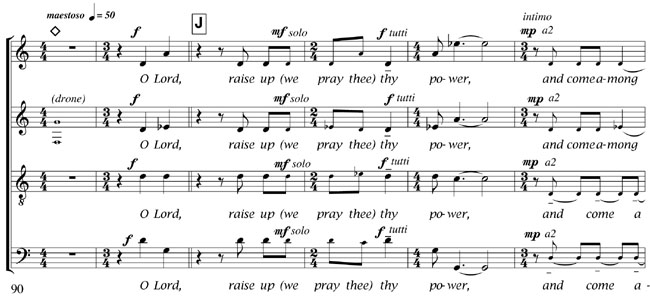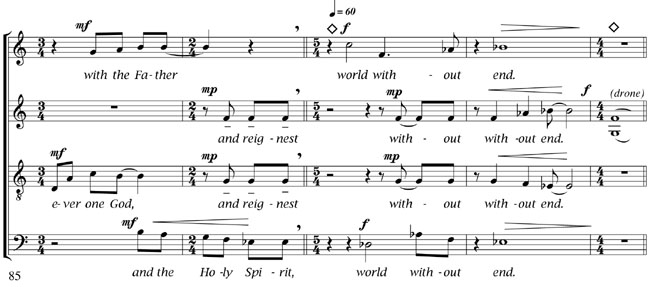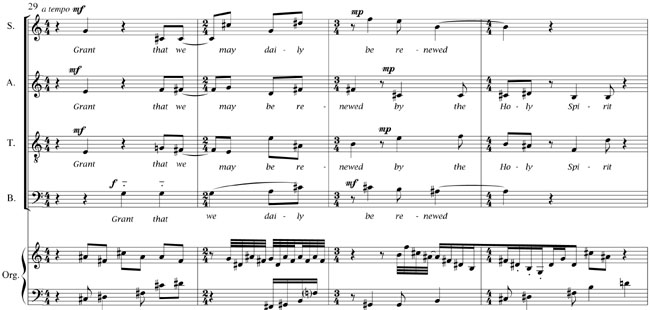
Opening bars of the Advent IV: Succour
Setting the Collects
The Collect is a form of prayer that gathers or ‘collects’ silent or expressed petitions. The chief characteristics have been described as variety and terseness. It has a unique and unwavering three-fold structure: an address, a petition, an ascription. This can be clearly seen for instance, in the collect for Trinity XVII:
Lord, we pray thee – that thy grace may always prevent and follow us, and make us continually to be given to all good works; – through Jesus Christ our Lord.
Nigel Morgan’s setting of the Collects is unusual in the canon of English liturgical music. Many composers have used lines from the collects within anthems, but it is rare to find complete settings of any of these beautifully concise prayers. J.W.C.Wand’s Reflections on the Collects, a celebrated selection of homilies on the collects for every week of the Church’s year, has been used to provide an authoritative choice of texts divided into the principal seasons of Advent, Christmas, Epiphany, Lent, Easter, and Trinity.

The final bars of Advent III: The Ministry
The Advent Collects was composed in 2002 for the Christmas Concert of the Yorkshire Philharmonic Choir held annually in Wakefield Cathedral. The work is thought of as a companion piece to the O Antiphons by Arvo Part, a challenging and beautiful piece often heard in Advent carol services. Nigel Morgan’s four Collects for Advent are considered here as musical prayers and meditations.
Each collect uses a different diad, which can act variously as a drone or signal for moments of repose. The diad, whose interval expands as the collects’ progress, may be sung, played on handbells, organ or scored for additional instruments. In the example above from the Collect for the 3 rd Sunday in Advent there are two instances where a diamond-like symbol is shown. This suggests to the singers that a brief pause can be made, during which the diad can be struck, or if it is held continuously, may be used by the choir to retune to the drone. Either way, this device gives the music a meditative, prayer-like quality.

from Christmas I: Sons of God
The Christmas Collects are altogether more straightforward in their setting and scored for choir (SATB) and chamber organ. Instead of using intervals as drones throughout each Collect as signals for meditative pauses and retuning, the Christmas Collects take a pair of intervals as their musical basis: the intervals of the minor third and perfect fifth in their harmonic relationship within the Locrian mode. The important chamber organ part is of quite a virtuoso character. In its use of false relations and ornamental figurations
it is full of resonances of the Early English organ style found in the pages of the Mulliner Book.

from Christmas II: Partakers of Thy Divine Nature
The Christmas Collects were written in 2004 as a gift for the Canon Pastoral of Norwich Cathedral Revd. Richard Capper and his family. These Collects act as a kind of upbeat to the composer’s The Text is A Star a festive cantata based on the celebrated sermon for Christmas Day by Bishop Lancelot Andrewes (upon which T.S. Eliot based his poem Journey of the Magi). Whilst the Advent Collects is suitable for large or small choral forces, the Christmas Collects definitely favour a choir of modest proportions, no more than 30 singers. Part of an on-going project to set all the collects belonging to the major seasons of the Church year The Epiphany Collects for soprano voices and organ and Lenten Collects for unaccompanied male voices will be available during the 2008.
Downloads
The Advent Collects: Study Score [pdf]
